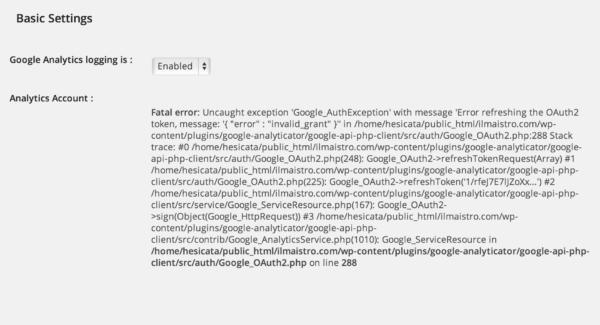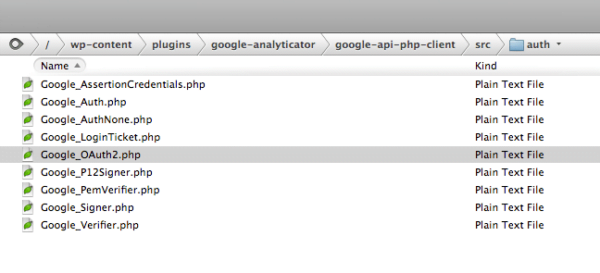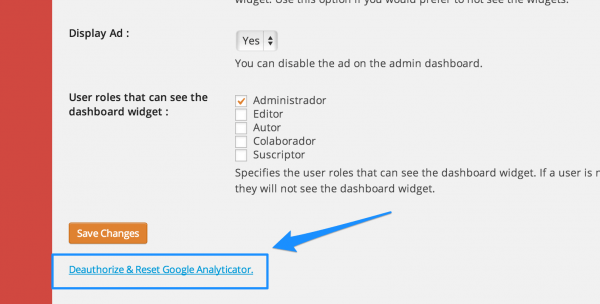Cómo resolver el problema «Fatal error: Uncaught exception ‘Google_AuthException'» del plugin Google Analyticator [WordPress]
![Cómo resolver el problema «Fatal error: Uncaught exception ‘Google_AuthException'» del plugin Google Analyticator [WordPress]](https://ilmaistro.com/wp-content/uploads/2013/02/Google-Analytics-1102x350.png)
Luego de decidir abandonar el uso de Google Tag Manager, opté por reinstalar el plugin Google Analyticator para medir las visitas al blog vía Google Analytics. Lamentablemente, a pesar de instalar la versión más reciente del plugin, fue recibido con un mensaje de error luego de la instalación: «Fatal error: Uncaught exception ‘Google_AuthException'». En este post les explicaré como resolver el problema.
Empecemos por recordar que Google Analyticator es un plugin para WordPress que nos permite instalar de forma sencilla Google Analytics a fin de medir las visitas en nuestro blog. Si nunca lo han instalado antes, no deberían tener problemas en hacerlo funcionar. Sin embargo, al menos en mi caso, luego de una reinstalación del plugin se me presentó el siguiente mensaje de error en la sección de opciones:
Leyendo información en la web, al parecer el problema es con la forma en que Google Analytics esta manejando la información que envía al plugin. Resolver el problema requiere que reemplacemos manualmente uno de los archivos del plugin. Sigan estos pasos:
1. Accedan vía FTP a su blog, y accedan al archivo Google_OAuth2.php ubicado en /wp-content/plugins/google-analyticator/google-api-php-client/src/auth/Google_OAuth2.php.
2. Abran el archivo. Reemplacen todo el contenido del mismo por este código (copien y peguen el código completo debajo):
<?php /* * Copyright 2008 Google Inc. * * Licensed under the Apache License, Version 2.0 (the "License"); * you may not use this file except in compliance with the License. * You may obtain a copy of the License at * * http://www.apache.org/licenses/LICENSE-2.0 * * Unless required by applicable law or agreed to in writing, software * distributed under the License is distributed on an "AS IS" BASIS, * WITHOUT WARRANTIES OR CONDITIONS OF ANY KIND, either express or implied. * See the License for the specific language governing permissions and * limitations under the License. */ require_once "Google_Verifier.php"; require_once "Google_LoginTicket.php"; require_once "service/Google_Utils.php"; /** * Authentication class that deals with the OAuth 2 web-server authentication flow * * @author Chris Chabot <[email protected]> * @author Chirag Shah <[email protected]> * */ class Google_OAuth2 extends Google_Auth { public $clientId; public $clientSecret; public $developerKey; public $token; public $redirectUri; public $state; public $accessType = 'offline'; public $approvalPrompt = 'force'; /** @var Google_AssertionCredentials $assertionCredentials */ public $assertionCredentials; const OAUTH2_REVOKE_URI = 'https://accounts.google.com/o/oauth2/revoke'; const OAUTH2_TOKEN_URI = 'https://accounts.google.com/o/oauth2/token'; const OAUTH2_AUTH_URL = 'https://accounts.google.com/o/oauth2/auth'; const OAUTH2_FEDERATED_SIGNON_CERTS_URL = 'https://www.googleapis.com/oauth2/v1/certs'; const CLOCK_SKEW_SECS = 300; // five minutes in seconds const AUTH_TOKEN_LIFETIME_SECS = 300; // five minutes in seconds const MAX_TOKEN_LIFETIME_SECS = 86400; // one day in seconds /** * Instantiates the class, but does not initiate the login flow, leaving it * to the discretion of the caller (which is done by calling authenticate()). */ public function __construct() { global $apiConfig; if (! empty($apiConfig['developer_key'])) { $this->developerKey = $apiConfig['developer_key']; } if (! empty($apiConfig['oauth2_client_id'])) { $this->clientId = $apiConfig['oauth2_client_id']; } if (! empty($apiConfig['oauth2_client_secret'])) { $this->clientSecret = $apiConfig['oauth2_client_secret']; } if (! empty($apiConfig['oauth2_redirect_uri'])) { $this->redirectUri = $apiConfig['oauth2_redirect_uri']; } if (! empty($apiConfig['oauth2_access_type'])) { $this->accessType = $apiConfig['oauth2_access_type']; } if (! empty($apiConfig['oauth2_approval_prompt'])) { $this->approvalPrompt = $apiConfig['oauth2_approval_prompt']; } } /** * @param $service * @param string|null $code * @throws Google_AuthException * @return string */ public function authenticate($service, $code = null) { if (!$code && isset($_GET['code'])) { $code = $_GET['code']; } if ($code) { // We got here from the redirect from a successful authorization grant, fetch the access token $request = Google_Client::$io->makeRequest(new Google_HttpRequest(self::OAUTH2_TOKEN_URI, 'POST', array(), array( 'code' => $code, 'grant_type' => 'authorization_code', 'redirect_uri' => $this->redirectUri, 'client_id' => $this->clientId, 'client_secret' => $this->clientSecret ))); if ($request->getResponseHttpCode() == 200) { $this->setAccessToken($request->getResponseBody()); $this->token['created'] = time(); return $this->getAccessToken(); } else { $response = $request->getResponseBody(); $decodedResponse = json_decode($response, true); if ($decodedResponse != null && $decodedResponse['error']) { $response = $decodedResponse['error']; } throw new Google_AuthException("Error fetching OAuth2 access token, message: '$response'", $request->getResponseHttpCode()); } } $authUrl = $this->createAuthUrl($service['scope']); header('Location: ' . $authUrl); return true; } /** * Create a URL to obtain user authorization. * The authorization endpoint allows the user to first * authenticate, and then grant/deny the access request. * @param string $scope The scope is expressed as a list of space-delimited strings. * @return string */ public function createAuthUrl($scope) { $params = array( 'response_type=code', 'redirect_uri=' . urlencode($this->redirectUri), 'client_id=' . urlencode($this->clientId), 'scope=' . urlencode($scope), 'access_type=' . urlencode($this->accessType), 'approval_prompt=' . urlencode($this->approvalPrompt) ); if (isset($this->state)) { $params[] = 'state=' . urlencode($this->state); } $params = implode('&', $params); return self::OAUTH2_AUTH_URL . "?$params"; } /** * @param string $token * @throws Google_AuthException */ public function setAccessToken($token) { $token = json_decode($token, true); if ($token == null) { throw new Google_AuthException('Could not json decode the token'); } if (! isset($token['access_token'])) { throw new Google_AuthException("Invalid token format"); } $this->token = $token; } public function getAccessToken() { return json_encode($this->token); } public function setDeveloperKey($developerKey) { $this->developerKey = $developerKey; } public function setState($state) { $this->state = $state; } public function setAccessType($accessType) { $this->accessType = $accessType; } public function setApprovalPrompt($approvalPrompt) { $this->approvalPrompt = $approvalPrompt; } public function setAssertionCredentials(Google_AssertionCredentials $creds) { $this->assertionCredentials = $creds; } /** * Include an accessToken in a given apiHttpRequest. * @param Google_HttpRequest $request * @return Google_HttpRequest * @throws Google_AuthException */ public function sign(Google_HttpRequest $request) { // add the developer key to the request before signing it if ($this->developerKey) { $requestUrl = $request->getUrl(); $requestUrl .= (strpos($request->getUrl(), '?') === false) ? '?' : '&'; $requestUrl .= 'key=' . urlencode($this->developerKey); $request->setUrl($requestUrl); } // Cannot sign the request without an OAuth access token. if (null == $this->token && null == $this->assertionCredentials) { return $request; } // Check if the token is set to expire in the next 30 seconds // (or has already expired). if ($this->isAccessTokenExpired()) { if ($this->assertionCredentials) { $this->refreshTokenWithAssertion(); } else { if (! array_key_exists('refresh_token', $this->token)) { throw new Google_AuthException("The OAuth 2.0 access token has expired, " . "and a refresh token is not available. Refresh tokens are not " . "returned for responses that were auto-approved."); } $this->refreshToken($this->token['refresh_token']); } } // Add the OAuth2 header to the request $request->setRequestHeaders( array('Authorization' => 'Bearer ' . $this->token['access_token']) ); return $request; } /** * Fetches a fresh access token with the given refresh token. * @param string $refreshToken * @return void */ public function refreshToken($refreshToken) { try { $this->refreshTokenRequest(array( 'client_id' => $this->clientId, 'client_secret' => $this->clientSecret, 'refresh_token' => $refreshToken, 'grant_type' => 'refresh_token' )); } catch (Google_AuthException $e) { echo 'AUTHORIZATION ERROR - RESET ALL GOOGLE AUTORIZATION. Error message: <div>', $e->getMessage(), "</div>\n"; } } /** * Fetches a fresh access token with a given assertion token. * @param Google_AssertionCredentials $assertionCredentials optional. * @return void */ public function refreshTokenWithAssertion($assertionCredentials = null) { if (!$assertionCredentials) { $assertionCredentials = $this->assertionCredentials; } $this->refreshTokenRequest(array( 'grant_type' => 'assertion', 'assertion_type' => $assertionCredentials->assertionType, 'assertion' => $assertionCredentials->generateAssertion(), )); } private function refreshTokenRequest($params) { $http = new Google_HttpRequest(self::OAUTH2_TOKEN_URI, 'POST', array(), $params); $request = Google_Client::$io->makeRequest($http); $code = $request->getResponseHttpCode(); $body = $request->getResponseBody(); if (200 == $code) { $token = json_decode($body, true); if ($token == null) { throw new Google_AuthException("Could not json decode the access token"); } if (! isset($token['access_token']) || ! isset($token['expires_in'])) { throw new Google_AuthException("Invalid token format"); } $this->token['access_token'] = $token['access_token']; $this->token['expires_in'] = $token['expires_in']; $this->token['created'] = time(); } else { throw new Google_AuthException("Error refreshing the OAuth2 token, message: '$body'", $code); } } /** * Revoke an OAuth2 access token or refresh token. This method will revoke the current access * token, if a token isn't provided. * @throws Google_AuthException * @param string|null $token The token (access token or a refresh token) that should be revoked. * @return boolean Returns True if the revocation was successful, otherwise False. */ public function revokeToken($token = null) { if (!$token) { $token = $this->token['access_token']; } $request = new Google_HttpRequest(self::OAUTH2_REVOKE_URI, 'POST', array(), "token=$token"); $response = Google_Client::$io->makeRequest($request); $code = $response->getResponseHttpCode(); if ($code == 200) { $this->token = null; return true; } return false; } /** * Returns if the access_token is expired. * @return bool Returns True if the access_token is expired. */ public function isAccessTokenExpired() { if (null == $this->token) { return true; } // If the token is set to expire in the next 30 seconds. $expired = ($this->token['created'] + ($this->token['expires_in'] - 30)) < time(); return $expired; } // Gets federated sign-on certificates to use for verifying identity tokens. // Returns certs as array structure, where keys are key ids, and values // are PEM encoded certificates. private function getFederatedSignOnCerts() { // This relies on makeRequest caching certificate responses. $request = Google_Client::$io->makeRequest(new Google_HttpRequest( self::OAUTH2_FEDERATED_SIGNON_CERTS_URL)); if ($request->getResponseHttpCode() == 200) { $certs = json_decode($request->getResponseBody(), true); if ($certs) { return $certs; } } throw new Google_AuthException( "Failed to retrieve verification certificates: '" . $request->getResponseBody() . "'.", $request->getResponseHttpCode()); } /** * Verifies an id token and returns the authenticated apiLoginTicket. * Throws an exception if the id token is not valid. * The audience parameter can be used to control which id tokens are * accepted. By default, the id token must have been issued to this OAuth2 client. * * @param $id_token * @param $audience * @return Google_LoginTicket */ public function verifyIdToken($id_token = null, $audience = null) { if (!$id_token) { $id_token = $this->token['id_token']; } $certs = $this->getFederatedSignonCerts(); if (!$audience) { $audience = $this->clientId; } return $this->verifySignedJwtWithCerts($id_token, $certs, $audience); } // Verifies the id token, returns the verified token contents. // Visible for testing. function verifySignedJwtWithCerts($jwt, $certs, $required_audience) { $segments = explode(".", $jwt); if (count($segments) != 3) { throw new Google_AuthException("Wrong number of segments in token: $jwt"); } $signed = $segments[0] . "." . $segments[1]; $signature = Google_Utils::urlSafeB64Decode($segments[2]); // Parse envelope. $envelope = json_decode(Google_Utils::urlSafeB64Decode($segments[0]), true); if (!$envelope) { throw new Google_AuthException("Can't parse token envelope: " . $segments[0]); } // Parse token $json_body = Google_Utils::urlSafeB64Decode($segments[1]); $payload = json_decode($json_body, true); if (!$payload) { throw new Google_AuthException("Can't parse token payload: " . $segments[1]); } // Check signature $verified = false; foreach ($certs as $keyName => $pem) { $public_key = new Google_PemVerifier($pem); if ($public_key->verify($signed, $signature)) { $verified = true; break; } } if (!$verified) { throw new Google_AuthException("Invalid token signature: $jwt"); } // Check issued-at timestamp $iat = 0; if (array_key_exists("iat", $payload)) { $iat = $payload["iat"]; } if (!$iat) { throw new Google_AuthException("No issue time in token: $json_body"); } $earliest = $iat - self::CLOCK_SKEW_SECS; // Check expiration timestamp $now = time(); $exp = 0; if (array_key_exists("exp", $payload)) { $exp = $payload["exp"]; } if (!$exp) { throw new Google_AuthException("No expiration time in token: $json_body"); } if ($exp >= $now + self::MAX_TOKEN_LIFETIME_SECS) { throw new Google_AuthException( "Expiration time too far in future: $json_body"); } $latest = $exp + self::CLOCK_SKEW_SECS; if ($now < $earliest) { throw new Google_AuthException( "Token used too early, $now < $earliest: $json_body"); } if ($now > $latest) { throw new Google_AuthException( "Token used too late, $now > $latest: $json_body"); } // TODO(beaton): check issuer field? // Check audience $aud = $payload["aud"]; if ($aud != $required_audience) { throw new Google_AuthException("Wrong recipient, $aud != $required_audience: $json_body"); } // All good. return new Google_LoginTicket($envelope, $payload); } }
3. Guarden los cambios y, en WordPress, regresen a la página de configuración del plugin (Opciones > Google Analytics). Verán que el mensaje de error ha desaparecido y que la página carga sin problemas. Sin embargo, aún hay referencia al error.
4. Como paso final, vayan hasta el final de la página de configuración del plugin y seleccionen la opción «Desauthorize & Reset Google Analyticator».
Problema resuelto! Ahora sólo deben volver a enlazar el plugin con su cuenta de Google Analytics.
Espero el post les haya servido de ayuda.




